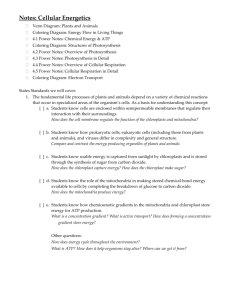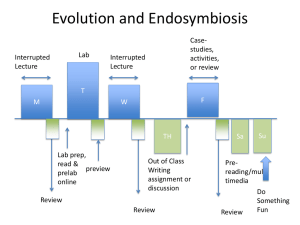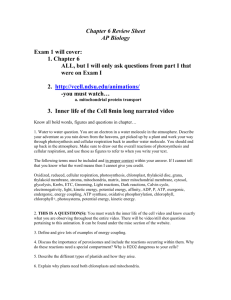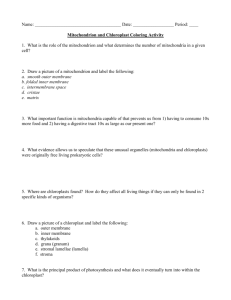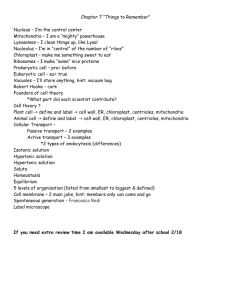AP Biology Discussion Notes
advertisement
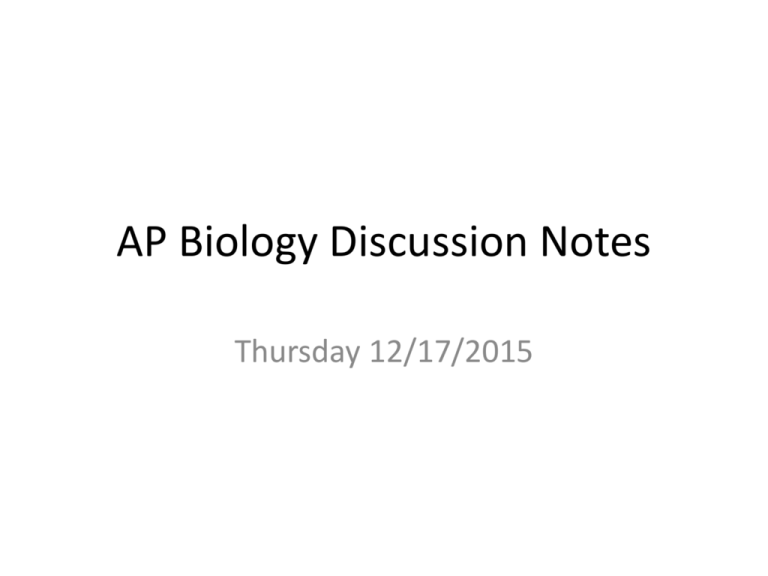
AP Biology Discussion Notes Thursday 12/17/2015 Goals for the Day • Understand what is unique about chloroplasts & mitochondria • Analyze & understand our cellular respiration Lab • Be prepared for our TEST MONDAY Question of the day 12/17 Why are cells so small or what limits cell size? Which cell is most efficient? Same Volume – different Surface area – How will this effect efficiency? What cell parts are associated with Cell respiration & Photosynthesis? Chloroplast • Site of photosynthesis – Light Energy -> Chemical Energy • Double-membraned • Stacks of thylakoids Mitochondria • Generate ATP from glucose – Generate ____________energy • Site of cellular respiration • Double membraned—cristae Mitochondria & Chloroplasts • Unique features: • Both are energy-related organelles • Have two membranes • Have their own DNA • Reproduce independently of the cell • Have Ribosomes Endosymbiotic (Endosymbiont)Theory • What does endo mean? • What is symbiosis? Endosymbiotic Theory • Mitochondria & Chloroplast came from independent prokaryotic cells through process of endocytosis. Provided benefits to both cells & an advantage – became common in population. Mitochondria & Chloroplasts EVIDENCE for Endosymbiotic Theory • Both are energy-related organelles • Have two membranes • Have their own DNA • Reproduce independently of the cell • Have Ribosomes Endosymbiotic Theory • If mitochondria and chloroplasts originally came from independent prokaryotes, what would be true of their DNA? (What do you know about the DNA of prokaryotes compared to Eukaryotes?) Endosymbiotic Theory Figure 6.16 Endoplasmic reticulum Nucleus Engulfing of oxygenNuclear using nonphotosynthetic envelope prokaryote, which becomes a mitochondrion Ancestor of eukaryotic cells (host cell) Mitochondrion Nonphotosynthetic eukaryote At least one cell Engulfing of photosynthetic prokaryote Chloroplast Mitochondrion Photosynthetic eukaryote Work Order for today 1. Come up with a list of major topics on our unit test 2. Finish lab analysis & ask questions 3. Chapter 9 Book Notes – 9.1 – 9.5 – 9.6 4. Work on studying/asking questions ASK QUESTIONS to each other to me! Major Topics on Test 2 • Evolution – – – Phylogeny interpretation Natural Selection (Population change NOT individual!) Biological fitness (Survival & Reproduction) • Nervous System – Basic Structures/Set up of membrane • – – Salty Banana Direction of signal transmission How signals are sent across synapse • Neurotransmitters Major Topics on Test 2 • Cell Transport – – – – – – Types (Passive vs. Active) Diffusion/Osmosis Lab Osmotic Solutions (Plasmolysis minilab) Water potential Osmoregulation (video notes) Cell size – SURFACE AREA/Volume ratio Major Topics on Test 2 • Cell Life Cycles – – – – – Parts/regulation of life cycle Types of cell division Mitosis vs. Meiosis Sources of Variation Advantages/disadvantages of sexual/asexual reproduction • Cells – – – Parts/Function Parts that work together What organisms have what cell parts Major Topics on Test 2 • Photosynthesis basics – – – Basic equation Pigments – chromatography Lab 10.1,10.2 • Cellular respiration – – – – Parts/purpose of process Oxidative vs. Fermentation Which organisms do which processes How do membranes help eukaryotes?


